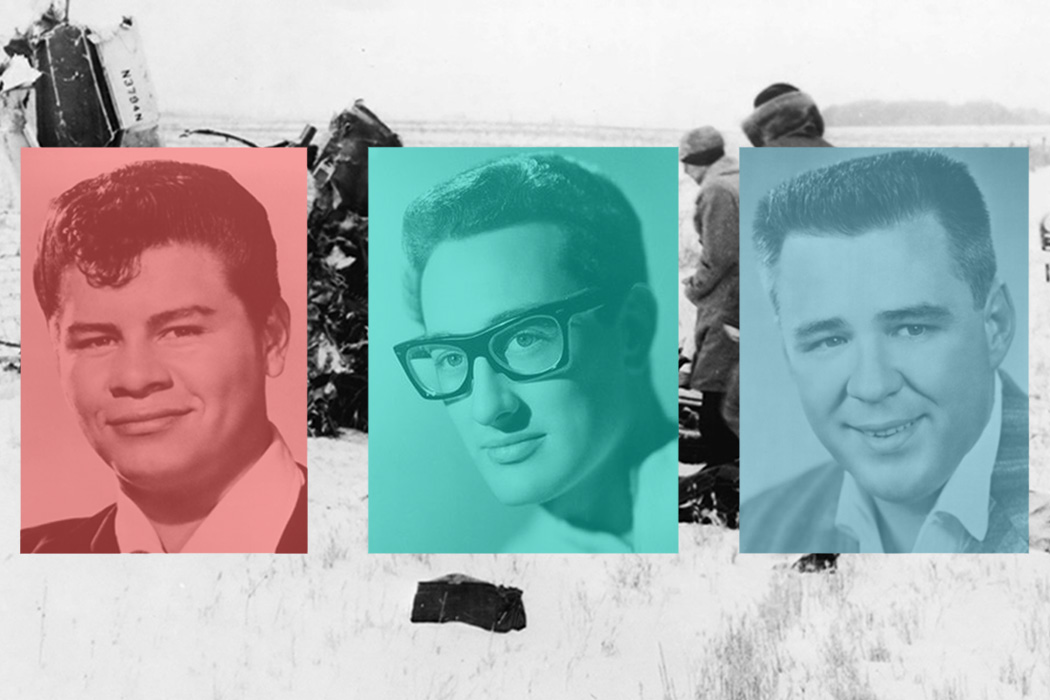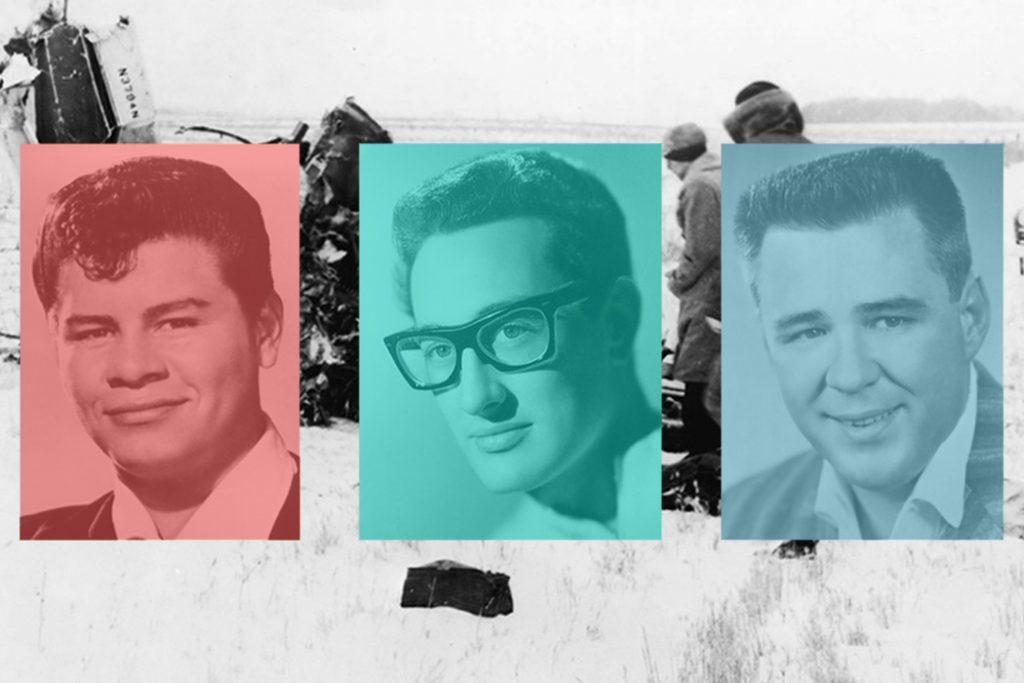
+ Welcome to Soundfly! We help curious musicians meet their goals with creative online courses. Whatever you want to learn, whenever you need to learn it. Subscribe now to start learning on the ’Fly.
One of the most significant tragedies in the history of rock ‘n’ roll, and certainly one of rock’s very first serious tragedies, happened on February 3rd, 1959. It was a shock for fans of the newly minted genre to see the lives of three of their own (one, already an icon, and two, up-and-coming) cut so short so fast. The moment came to be known as “day the music died.”
In commemoration of the anniversary, let’s take a minute to reflect on the three artists lost that day, and just a few of the many musicians taken from us too soon.
Ritchie Valens, a pioneer of Spanish-infused music, was well on his way to success. As a Mexican-American musician, he had found his way to the top of the pop charts with hits like “Donna” and “La Bamba.” The latter, entirely in Spanish, was a rarity in and of itself — a hit on the American charts in a language other than English was nearly unheard of, especially in the 1950s. (*Check out music theorist Philip Tagg’s analysis of “La Bamba” in this article!)
J.P. Richardson (popularly known as “The Big Bopper”) was a disc jockey and singer-songwriter. Although he was just beginning his career as a performer, his biggest-ever hit, “Chantilly Lace,” burned up the charts for twenty five weeks. Here he is performing that song goofily live for television.
The biggest star out of the three was no doubt Buddy Holly, who had recorded enduring hits like “Peggy Sue,” “That’ll Be The Day,” “Rave On,” and “Every Day,” and had already made a lasting impression as a rock ‘n’ roll icon in his short career. In the decades since his untimely death, his songs have been covered thousands of times over, by many major artists including Elvis Costello, The Beatles, and the Rolling Stones. (And of course, we can’t forget about Weezer’s own hit, entitled “Buddy Holly.”)
The Day the Music Died
The fact that February 3, 1959 has come to be known as “The Day the Music Died” is hardly an understatement. It had a massive impact on the early rock ‘n’ roll music scene. It all started with a hectic, insanely scheduled national tour.
The three artists were booked together in a doomed revue that would visit 24 cities in 24 days, which barely left enough time for travel. Holly, along with Ritchie Valens, Dion and the Belmonts, and J.P. Richardson, were touring by bus. During the freezing Midwest winter, the bus’ heating system broke, sending Holly’s drummer to the hospital for frostbite. Several other musicians got the flu over the course of a couple weeks.
Eventually, Holly reached his limit. The singer decided to charter a plane after their gig at the Surf Ballroom in Clear Lake, Iowa. It would prove to be his last show.

The plane that was hired — a single-engine Beechcraft Bonanza — was only large enough to accommodate three passengers. Initially, the idea was that Holly and his band would be the ones to take the seats. But Richardson, who was battling the flu, begged for a seat on the plane. Waylon Jennings, the future country star and Holly’s bassist at the time, acquiesced, with some good natured ribbing between him and Holly:
“I hope your bus freezes up!” Holly told Jennings.
“I hope your ol’ plane crashes!” Jennings quipped back.
This comment would end up haunting Jennings for the rest of his life. Tommy Allsup, the guitarist for Holly’s band, flipped a coin with Valens for his seat on the plane. And with that, the seats on the ill-fated flight were decided.
Immediately after the show, Holly, Valens, and Richardson took off from the Mason City Municipal Airport in Iowa, and flew only six short miles before crashing, nose down, at a high speed in a field northwest of the airport. The semi-mysterious crash is largely believed to have been the result of pilot error — the pilot was inexperienced and under-certified. However, the bad weather that was expected along the flight path was never actually reported to him — visibility was diminishing at the airport and a light snow had begun to fall at the time of takeoff.
This accident was immortalized in Don McLean’s epic song “American Pie,” a beautiful and allegorical tribute to both the event itself and the American culture it left in its wake.
This accident is one of the most significant in music history, but there have certainly been others. Sometimes bands are able to climb the ladder and achieve success, only to have it cruelly ripped away by the rock gods. For whatever reason, as we’ll soon see, some bands just seem singled out for misfortune.
Badfinger

In 1969, Badfinger seemed to be geared up for success. After some initial false starts, a white knight by the name of Paul McCartney came riding in — he not only offered them one of his own compositions (“Come and Get It” — which went on to be one of the band’s biggest hits), but produced a couple of their songs as well. He even brought in George Martin to help arrange the strings.
As is sometimes the case, success led to turmoil. There were conflicts between band members, conflicts with their label, and impending lawsuits. On top of this, they had signed a shady contract with a manager. It all combined to create the perfect storm to derail an otherwise promising band. The label refused to support their album and pulled their follow-up project. The paychecks to band members bounced, their manager was unreachable, and they found out they had no money left. They couldn’t even work directly with venues to book their own shows due to the restrictive contract they signed.
The misfortune drove lead singer and founding member, Pete Ham, to commit suicide. It was the final straw for a very fragile band, and the remaining members broke up, with lawsuits and financial ruin hanging over their heads. Although it took nearly a decade, the band eventually reformed, only to bitterly break up again with two feuding members (Tom Evans and Joey Molland) forming rival bands, both called Badfinger. Following a heated phone call with Molland regarding money, Evans then himself committed suicide. The music of the band lives on through their body of work which has been reissued in the years since.
The Exploding Hearts

There’s a good chance you’ve never heard of this Portland-based band — their tragedy occurred right as they were beginning to garner a national following in 2003. Just as they were about to embark on a national tour to support their critically-lauded debut album, Guitar Romantic, The Exploding Hearts experienced a horrific highway crash.
The lead singer, the drummer, and the bassist were all ejected from the van when it flipped twice after careening out of control at a high speed. Two were declared dead at the scene, and one later passed away from his injuries. All were in their early 20s. Guitarist Terry Six and the band’s manager were the only ones wearing a seat belt, and only suffered minor injuries. It is tragic that such a promising young band was struck down a matter of mere moments. They may have become a household name today if not for that.
Lynyrd Skynyrd

This band, on the other hand, is one everyone’s heard of. To this day, their hits “Sweet Home Alabama,” “Freebird,” and “Simple Man,” are ubiquitous on classic rock radio. They formed in 1964 but only started calling themselves Lynyrd Skynyrd in 1969, and their sound gained major attention through the early ’70s. By the mid ’70s, the band had hit singles, gold and platinum records, and were headlining stadium shows.
In October of 1977, however, a fatal plane crash would end all that. To start with, the plane they were flying in wasn’t exactly considered safe — supposedly Aerosmith also looked into chartering it but declined, citing safety concerns. Whatever the reason, the band chose that plane to shepherd them around the country for the biggest tour of their careers to date. As sound engineer Paul Welch tells it, there were several identifiable problems from the beginning of the ride as they took off from an airport in South Carolina; the air conditioning wasn’t working making the cabin very hot, the fuel mixture wasn’t right from takeoff, and one of the two engines was shoddy.
But the real tragedy unfolded when the plane started to run out of fuel over Mississippi, and the pilot was forced to make an unsuccessful emergency landing. The crash killed singer Ronnie Van Zant, vocalist Cassie Gaines, guitarist Steve Gaines, and assistant road manager Dean Kilpatrick. Both pilots were also killed on impact. Other members of the band survived, and managed to crawl from the wreckage, burned and bloody, and trek through the remote woods to flag down help. In an ironic twist, the band’s album, Street Survivor, that they were touring in support of, went platinum shortly after. The surviving members of the group reunited a decade later and continue to tour, though the only original member left is Gary Rossington.
Otis Redding and the Bar Kays

Otis Redding’s name is synonymous with soul music. In 1967, he hadn’t yet reached his peak, although he did already have numerous hits under his belt, including, “Try a Little Tenderness” which is so iconic it was recently sampled by Jay-Z and Kanye West.
The Bar Kays, who would ultimately go on to tour with Otis, backed some of the biggest soul acts of the era as a rhythmic unit. They were established artists in their own right, having a Top 20 hit of their own with “Soul Finger.” In a sad day for music, Redding and the Bar Kays boarded a plane for a concert and TV appearance in Wisconsin. But they would never arrive. Seven of the eight men on board, including Redding, were killed. Redding was just 26 years old. Four months after Redding’s death, “Sittin’ on the Dock of the Bay” was released posthumously. It would be his first number one song.
The sole survivor of the plane crash, trumpet player Ben Cauley, reformed the Bar Kays with bass player James Alexander. As of 2017, they were still touring.
As long as there is music, there will always be those brilliant artists who were taken from us too soon, and this list is by no means complete. We honor these artists, and all artists taken from us before their time and are comforted by the legacy their creative spirit has given us. Their music lives on and there’s something magical about that.
Want to get all of Soundfly’s premium online courses for a low monthly cost?
Subscribe to get unlimited access to all of our course content, an invitation to join our members-only Slack community forum, exclusive perks from partner brands, and massive discounts on personalized mentor sessions for guided learning. Learn what you want, whenever you want, with total freedom.




